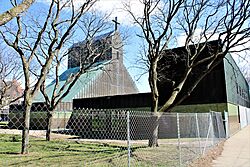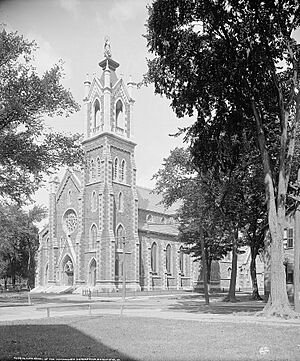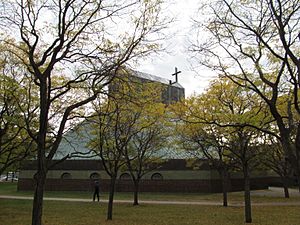Cathedral of the Immaculate Conception (Burlington, Vermont) facts for kids
Quick facts for kids Cathedral of theImmaculate Conception |
|
|---|---|

The former cathedral in 2022
|
|
| 44°28′47.05″N 73°12′53.56″W / 44.4797361°N 73.2148778°W | |
| Location | 20 Pine Street Burlington, Vermont |
| Country | United States |
| Denomination | Catholic Church |
| History | |
| Status | Desacralized |
| Founded | 1830 |
| Dedication | Immaculate Conception |
| Dedicated | May 26, 1977 |
| Architecture | |
| Architect(s) | Edward Larrabee Barnes Alistair Bevington (associate architect) |
| Style | Modern |
| Completed | 1977 |
| Closed | December 2018 |
| Specifications | |
| Capacity | 450 |
| Materials | Brick, Standing Seam Copper |
| Administration | |
| Diocese | Burlington |
The Cathedral of the Immaculate Conception was once a very important church in Burlington, Vermont, United States. It served as the main church for the Catholic Diocese of Burlington. The building is located on Pine Street. In 2018, it was announced that the building would no longer be used as a Catholic church. After being empty for a while, and put up for sale, the church leaders decided to get permission to take it down.
Contents
History of the Cathedral
The church started as a parish called St. Mary's in 1830. The church building that was finished in 1841 became a "pro-cathedral" when the diocese was created in 1852. A pro-cathedral is a church that serves as a cathedral temporarily.
The First Cathedral (1867)
Building the first Immaculate Conception Cathedral began in 1862. It took until 1867 to finish because of the American Civil War. The Chapel of St. Patrick, which was behind the cathedral, was built first.
This first cathedral was designed in the Gothic Revival style. It was made from red stone found nearby. Other local materials like marble and slate were also used. This was the first Catholic church in New England that was built and dedicated specifically as a cathedral.
The church was officially opened on December 8, 1867. At that time, its tall tower was not yet finished. The tower was completed in 1904. A large statue of Notre Dame de Lourdes was placed on top of its spire. This statue was 14 feet (4.3 meters) tall and covered in gold leaf.
Sadly, this beautiful church was destroyed by a fire on March 13, 1972. Firefighters tried to stop the blaze, but the bell tower fell down shortly after midnight.
The Second Cathedral (1977)
In 1974, a famous architect named Edward Larrabee Barnes was chosen to design a new cathedral. It would be built on the same land. The new church was designed in a modern style. It had five sides and low brick walls. The roof was made of high standing seam copper.
The new cathedral was designed to hold 450 people. This was because the number of Catholic churchgoers had become smaller. A large stained glass window called the "Great Cross" was placed in the west wall. Other beautiful windows were also added.
A landscape architect named Dan Kiley designed the park-like area around the church. He and Barnes worked together on the whole project. Kiley placed the building in the middle of the block. He planted 123 locust trees in a grid pattern. These trees helped to shield the church from the busy city streets.
A separate steel bell tower was built near the corner of Cherry and St. Paul Streets. This is where the old cathedral used to stand. A 4,500-pound (2,041 kg) bell was saved from the ruins of the first cathedral. This bell had been acquired in 1900. The new building and landscaping were finished in March 1977. The church was officially opened on May 26, 1977.
The pipe organ inside the church was built in 1980. It has 1,000 pipes and can play many different sounds.
Changes and Closure
Over time, the neighborhoods around the church changed. This affected the number of people attending. In 1999, another church in Burlington, Saint Joseph Church, was also named a "co-cathedral." This meant it shared the role of the main church.
Because fewer people were attending and there were financial challenges, the two Burlington cathedrals began to merge in 2017. The number of church members at Immaculate Conception had dropped to less than 100. Most Sunday Masses were held at St. Joseph. Immaculate Conception only had a weekday Mass and a monthly Mass in Vietnamese.
In April 2018, Immaculate Conception lost its status as a cathedral. Later that year, the bishop announced that the building would no longer be used as a church. On October 11, 2018, the diocese said it would sell the property. The last Mass was held in the church on December 8, 2018.
In December 2021, the diocese asked for permission to take down the church building. This permission was given in early 2023. A group of local residents tried to stop the demolition. They wanted to save the building because it was designed by two very important architects of the 20th century, Barnes and Kiley. However, they lost their appeals in court in February 2024 and December 2024. The group that owns the building is now working on getting the money to take it down.
See also
 In Spanish: Catedral de la Inmaculada Concepción (Burlington) para niños
In Spanish: Catedral de la Inmaculada Concepción (Burlington) para niños




